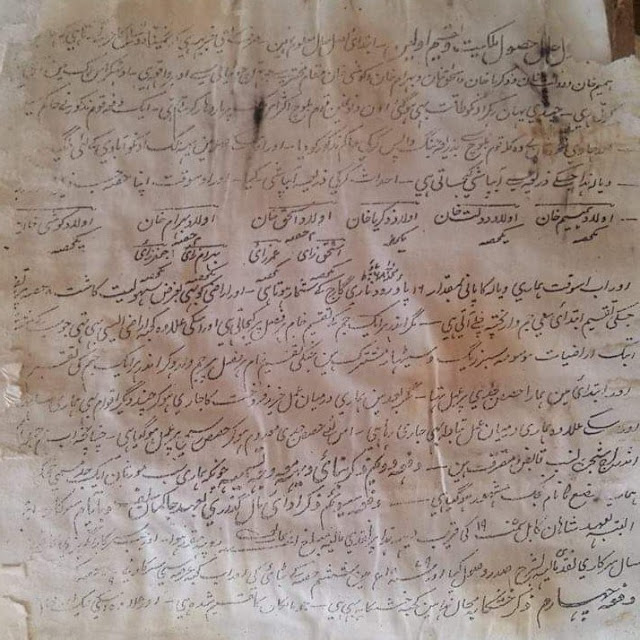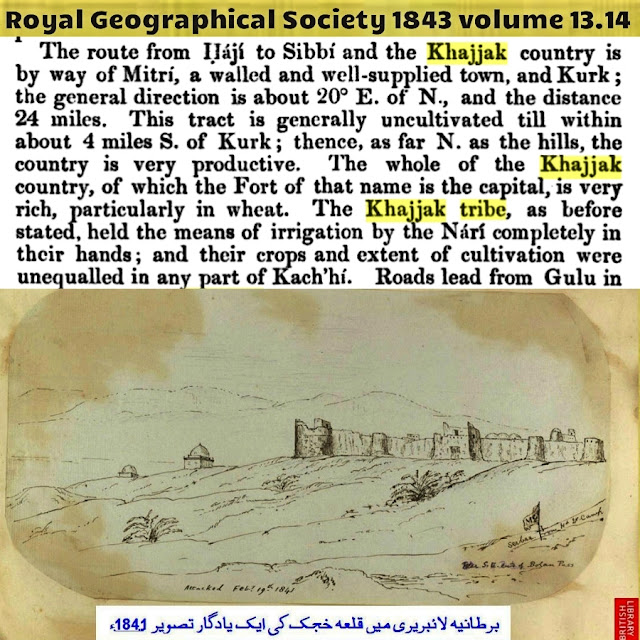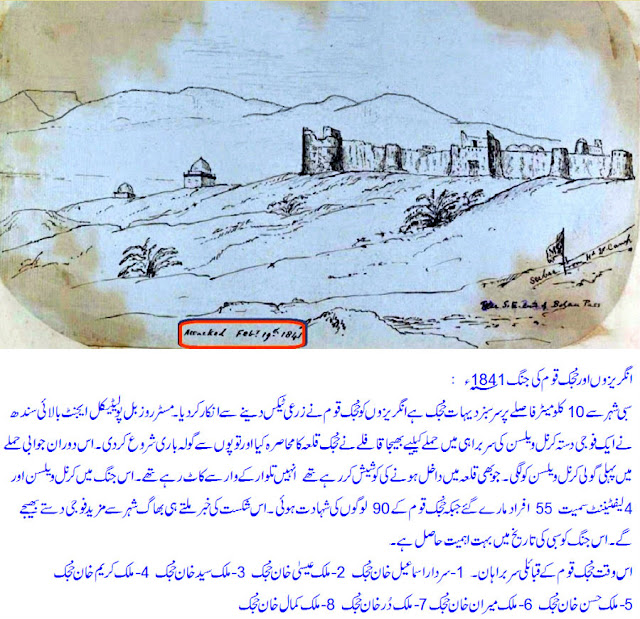Khajjak Town of Sibi District
It is during Taimoor Shah’s period that Khajjaks gained a popular saying in the local populace that ‘though the Kakars may conquer in the hills, the Khajjak lord it in the plains’ .
 |
| Khajjak Town |
The
Khajjaks, were initially located at Mekhtar; which is nowadays in the
possession of Kakars. In the latter half of 17th century Kakars defeated
them in a feud, which resulted into their migration to Sibi. Sibi was
then ruled by Junaid Khan, son of Baro Khan, the Progenitor of Barozai.
According to Abdul Aziz Luni, author of “Afghans of the frontier
passes”, the Khajjaks recovered a herd of Camels from the Baloch raiders
that belonged to Junaid Khan . The latter, in recognition of their
services gave them the land and water. Captain N.Hart writes that
Khajjaks were granted one cubit’s breadth of water of Nari river for
irrigation. When Khajjaks increased in numbers and power, they obtained
increase in share of water from Nawab Mirza Khan, son of Junaid Khan
Barozai.
 |
| Khajjak Tribes Land Revenue Record |
They
started harassing their own Afghan kinsmen. The Marghzanis were their
first victims. The Barozai rulers antagonized them by frequent
complaints to the Afghan Kings of Afghanistan. But Khajjaks succeeded in
in establishing direct relationship with the Afghan King and got
political recognition as well as grant of land and water in Khajjak’s
revenue circle. The in-fight helped the Balochs to encroach upon Panni
lands and later drove them out of some of the important tracts. Khajjaks
never defended other Panni clans from the raids and forays of their
Baloch neighbours. The Pannis, harassed by Balochs, migrated to village
Kurak and the Khajjaks occupied the lands thus vacated. Subsequently,
they started harrying the Baruzai. They helped the Marris in double
squeeze of the Panni clans in Sibi tract. The elders of the area refer
to this period of Sibi as ‘Highhandedness of Marris and Khajjaks’.
 |
| Khajjak Society |
Mc Gregor writes,“Though
agriculture is their chief employment and though they are peacefully
inclined they are said to have a high character for bravery.” . The
power of Khajjaks was crushed by the British army in March 1841 so that
they left the plains of Sibi and Sangan defenseless against the Marri
inroads. In 1872, the Khajjaks openly refused to accept the writ of Amir
Sher Ali Khan of Afghanistan who did not give them any protection
against the Marris and stopped the payment of revenues to Amir. The Amir
sent a force that too the chief of Khajjaks along with his son, as a
hostage to Kandahar for payment of revenue due from Khajjaks.
Anglo-Khajjak battle 1841
In
1839, Misri Khan Barozai, the head of the Panni tribe, tendered his
services to Shah Shuja and was taken into British service with a number
of his followers, who were styled incorrectly the ” Baloch Levy.” In
March 1841, Mr. Ross Bell, the Political Agent in Upper Sind, deputed
one of his assistants with a detachment of troops, under the command of
Colonel Wilson of the Bombay Cavalry, to collect the arrears of revenue
due from the Khajjaks of Sibi on behalf of Shah Shuja. The detachment
was accompanied by Misri Khan, and on the Khajjaks refusing to comply
with the demands, attacked the town, but were repulsed with heavy loss,
losing fifty- three men killed and wounded and four officers including
Colonel Wilson. Reinforcements from Bhag were sent up under General
Brooks, but before they could arrive the Khajjaks abandoned their
town,the defenses of which were then demolished. The power of the
Khajjaks was thus weakened, and shortly afterwards the Marris acquired a
footing in the Sibi District. They dispossessed the Pannis of Badra and
Quat-Mandai and over-ran Sangan.
Notes and References
- A.Aziz Luni, “Afghans of the frontier passes”, Vol-I, p-108
- There is also a saying, “Balochan-i-Marri bar koh minazand, wa mardumi Khajjak dar maidani goi shujaat mi rubayand” Translated from Persian in English language the- proverb will read as follows – “Marri Baloch are proud of their mountains whereas Khajjaks are proud of their bravery in the plain area.
- Haroon Rashid, “History of the Pathans”, Vol-III, p-99
- Mc Gregor, “North-West Frontier Province”, Vol-II, p-940
- Baluchistan District Gazetteer Series: Sibi district, compiled by Major.A. McConaghey, p-26
 |
| Old Airport in Khajjak Village |
The
British colonial influence started extending to Sibi region in the late
forties of the 19th century, when in 1839, Misri Khan, the head of
Panri tribe, tendered his services to Shah Shuja, and was taken into
British service with a number of his followers, who were styled the
“Baloch Levy. Subsequent events are a story of long and intense tribal
wars that paved the way for ultimate annexation of the Sibi region to
the British colonial empire. An entertaining account of the political
events after Misri Khan’s induction into British service is given in an
old (undated) Gazetteer of Sibi; of which relevant excerpts are
presented below:
 |
| Anglo Khajjak Battle 1841 |
“In
March 1841, Mr. Ross Bell, the Political Agent in upper Sind, deputed
one of his assistants with a detachment of troops, under the command of
Colonel Wilson of the Bombay Cavalry, to collect the arrears of revenue
due from Khajaks of Sibi on behalf of Shah Shuja. The detachment was
accompanied by Misri Khan, and on the Khajaks refusing to comply with
the demands, attacked the town, but were repulsed with heavy loss…….
Reinforcements from Bagh were sent up under General Brooks. But before
they could arrive the Khajaks abandoned their town, the defence of which
were then demolished. The Khajaks were permitted to return during the
following year and the town was rebuilt. From November 1841 to September
1842 an Assistant Political officer, resided at Sibi. When the British
troops were withdrawn from Afghanistan on the termination of the war,
the district was handed over by the British to the Khan of Kalat, but it
does not appear to have been occupied by him, and in 1843 again came
under the Baruzai rule —-. up to the second Afghan war Sibi continued to
be held by the Baruzai chiefs as governors of the Afghan rulers; but
owing to the constant raids and encroachments of the Marris, the country
was, at the request of the Sardars and people, occupied at the
commencement of the war by a detachment of troops from Jacobabad…… In
November 1887 the Kach-Kowas and Harnai valleys, Sibi, Duki and
Thal-Chotiali were declared parts of British India…… Owing to the
disputes between the Zarkuns and the Marris, Kohlu was brought under the
British protection and added to the Thal-Chotiali district in 1892. In
February 1891 Sanjawi was again transferred to Thal-Chotiali, and
Barkhan was added in April 1892. On reconstruction of the district in
October 1903, the Barkhan, Duki and Sajawi tehsils were transferred to
the new Loralai district, and the name of the Thal-Chotiali district was
changed into that of Sibi district.”






No comments:
Post a Comment